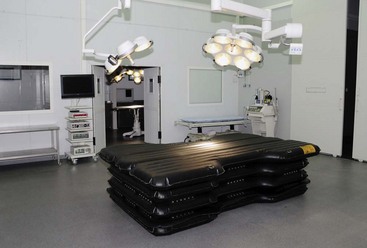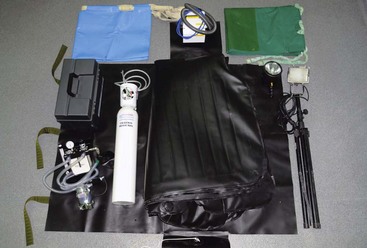Chapter 17 Fundamentals of Zoo Animal Surgery
Surgical Facilities and Equipment
Surgical Area
It would be beneficial to have two surgery rooms, one for small and another one for large animals, because of specific requirements in regard to equipment, surgical tables, and annexed rooms (Fig. 17-1). The surgical area must follow general standards in terms of security, patient and staff circulation, clean and comfortable environment, and proper organization, as described in literature reports.9,12,14 A video recording system is of particular interest in these procedures as a means of documentation and sharing information.
With the increasing sophistication of surgical techniques and instrumentation available today, surgeries outside a proper surgical facility are becoming less common.14 Nevertheless, occasionally, field surgery is still the option for zoo animals. This is the prevailing choice for large mammals or patients requiring short-duration anesthesia, or even for quick patient anesthetic recovery in an enclosure. In these circumstances, it is useful to have additional portable equipment available—namely, a good light, anesthesia device, oxygen tank, transport stretcher, and adequate surgical tables (e.g., inflatable systems; Fig. 17-2).
Surgical Instrumentation
TABLE 17-1 Basic Microsurgery Pack for Delicate Surgery*
| Quantity | Instrument |
|---|---|
| 4 | Baby mosquito hemostats, curved and straight, 3.75 inches (95 mm) |
| 2 | Hemostatic clips |
| 1 | Adson tissue forceps, 4.75 inches (120 mm) |
| 1 | Iris forceps |
| 1 | Microscalpel blade handle, 5.5 inches (135 mm) |
| 1 each | Stevens tenotomy scissors, curved and straight |
| 1 | Iris scissor, straight |
| 1 | Castroviejo needle holder |
| 10 | Sterile cotton-tipped applicators |
| 10 | Gauze swabs, 0.8 × 0.8 inch (20 × 20 mm) |
* Binocular magnification loupes, 2.5 to 5×.
TABLE 17-2 Basic Pack for Small- to Medium-Sized Animals
| Quantity | Instrument |
|---|---|
| 3 | Halstead mosquito hemostats, curved and straight, 5 inches (125 mm) |
| 4 | Kelly forceps, curved, 5.5 inches (140 mm) |
| 4 | Rochester-Pean forceps, curved, 7.25 inches (185 mm) |
| 1 | Rat-toothed forceps, 5.75 inches (145 mm) |
| 1 | Brown-Adson tissue forceps, 4.75 inches (120 mm) |
| 2 | Allis tissue forceps, 6 inches (150 mm) |
| 1 each | Scalpel handles, No. 3 and 4 |
| 1 | Metzenbaum scissors, curved, 7 inches (180 mm) |
| 1 | Metzenbaum scissors, straight, 7 inches (180 mm) |
| 1 | Mayo scissors, curved, 6.5 inches (165 mm) |
| 1 | Mayo-Hegar, Olsen-Hegar or Mathieu needle holder, 7 inches (180 mm) |
| 1 | Suture scissors |
| 4 | Towel forceps (Backhaus), 5.25 inches (135 mm) |
| 1 | Saline bowl |
| 10 | Gauze swabs, 4 × 4 inches (100 × 100 mm) |
TABLE 17-3 Basic Pack for Large Animals
| Quantity | Instrument |
|---|---|
| 2 | Halsted mosquito hemostats |
| 6 | Kelly forceps |
| 2 | Kocher-Ochsner forceps |
| 2 | Rochester-Pean forceps |
| 3 | Rat-toothed forceps |
| 1 | Brown-Adson tissue forceps |
| 2 | Allis-Thoms tissue forceps, 8 inches (200 mm) |
| 1 | Scalpel handle, No. 4 |
| 1 | Metzenbaum scissors, straight, 8 inches (200 mm) |
| 1 | Mayo scissors, curved, 8.25 inches (210 mm) |
| 1 | Mayo scissors, straight, 8 inches(200 mm) |
| 1 | Mayo-Hegar, Olsen-Hegar, or Mathieu needle holder, 8 inches (200 mm) |
| 1 | Suture scissors |
| 6 | Roeder towel forceps |
| 1 | Saline bowl |
| 50 | Gauze swabs, 8 × 8 inches (200 × 200 mm) |
In recent years, technologic advances have led to unprecedented access to new surgical equipment. Although high prices normally delay the integration of newly developed equipment in veterinary medicine, it becomes more affordable over time. Nevertheless, surgeons must become familiar with equipment before its practical application, acknowledging its advantages and its potential limitations. The use of equipment such as stapling devices, surgical lasers, and recently developed vessel sealing systems has become increasingly more common. When used correctly, this equipment has proven its value. Stapling devices may decrease the time of surgery needed for anastomoses and ligations and may also minimize the associated contamination. LigaSure (Covidien, Mansfield, Mass), a modern bipolar vessel sealing system, and Ultracision (Ethicon, Somerville, NJ), a system of ultrasound energy–based shears, are more efficient methods of coagulation when compared with monopolar and bipolar electrocoagulation.7
Stay updated, free articles. Join our Telegram channel

Full access? Get Clinical Tree




